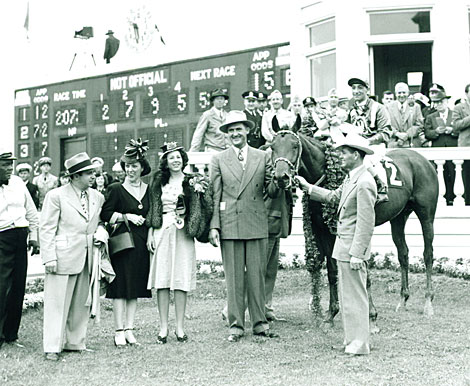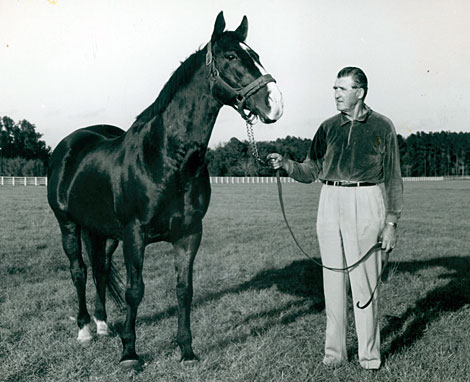The charm of horse racing lies primarily in the animals that do
it—their beauty, grace, power and their degree of class. But there is an
undeniable attraction to the colorful human beings that make it happen.
The purpose of this blog is to share my stories about some of these
characters. My requisites in the selection: I had dealings with them,
their antics and accomplishments should not be forgotten, and that at least most of them are
no longer with us. — Cot Campbell
Fred Hooper was
his own man—for 102 years! And he was one in a million. He seemed to have been
born knowing about a racehorse, and when he was able to indulge that knowledge,
he got the job done.
The only
significant "career-path" education this poor boy ever got was as a graduate of
Moler Barber College in Atlanta. After he practiced for a few months cutting
the locks of derelicts that wandered in off the streets for a free one, he
packed his comb, scissors and clippers and headed out for the construction
camps that were mushrooming across Dixie. He cut hair, did some prize fighting,
hustled around, and by osmosis, learned the rudiments of construction. In time
Hooper Construction Company was building highways, airports and race tracks.
Fred got rich. He was smart, tough and has been described as "unabashedly
unsophisticated."
Fred Hooper
understood livestock, liked racing (and the gamble that it involved), followed
bloodlines and really did have an authentic eye for an equine athlete. In 1943,
he hauled off and went to the Keeneland yearling sale, and bought a colt by Sir
Gallahad. That sucker won the Kentucky Derby two years later. His name was Hoop
Jr. Hooper picked out the horse, and from that time on he depended on his own judgment
on how to breed them, and how to train them. He had knowledgeable trainers but
they knew going in that the boss was Fred Hooper.

1945 Kentucky Derby winner Hoop Jr.
Did he ever
breed some good ones! The super stars were Susan's Girl, Crozier, Admiral's
Voyage, Copelan, Precisionist, Tri Jet, and Olympia (about whom more in a
moment). In total, he bred more than 100 stakes winners and they earned in
excess of $50 million (when fifty big ones was tougher to come by).
Whenever I
would run into Fred, I would tell him that I had just enrolled in Moler Barber
College, hoping that maybe that would make my horses run like his did. Not a
great line perhaps, but he liked it.
His expertise
also ran to the ability to discover and launch some of the greatest jockeys in
the history of racing. Lord knows how he was able to uncover Braulio Baeza,
Laffit Pincay Jr., and Jorge Velasquez. He brought them out of Central America
to this country and sponsored them.
But on to
Olympia.
Olympia turned out to be one of the fastest horses of all
time and a predominant speed influence on the breed. It was Olympia who was to
represent the Thoroughbred in one of the shortest, and most dramatic, races
ever run: the famous match race against the fastest Quarter Horse in the world.
Stella Moore was her name and a quarter-mile was her game!
Stella had defeated a very fast California Thoroughbred named
Fair Truckle. The swift mare's owners next approached Hooper and threw down the
gauntlet: quarter mile, Tropical Park in Miami, $25,000 put up by each side,
Stella Moore versus Olympia.
The super-quick Olympia was as game as Dick Tracy. And so was
Fred Hooper. Done!

Fred Hooper and Olympia, 1966
There was to be no pari-mutuel wagering on this match race. It
was an exhibition, approved by the state.
The race was on, and a sell-out crowd filled the Tropical
Park grandstand. Half the attendees showed up in ten-gallon hats and cowboy
boots. And they were loaded with Stella Moore money.
Fred Hooper covered every dime of it and was looking for more
at post time.
In charge of these special proceedings was the racing
secretary of Tropical Park, Pat Farrell. A big part of his job that day was
recording the bets. As he received money (legal tender), he pushed it into the
top right drawer of his desk and locked it. At post time, he then locked the
door to the racing secretary's office and rushed out to see the making of
racing history.
At this point Hooper had put up his $25,000 stake, as had
Stella's man, and Hooper had single-handedly covered about one hundred grand in
bets from numerous Quarter Horse enthusiasts. This was very big money in the
late forties.
When the starter sprung the latch, Olympia flashed his
vaunted speed, got the drop on Stella Moore, and held her safe to the wire, winning by the rapidly vanishing margin of a head.
The finish was scary, but not nearly as scary as the settling
of the bets.
After pictures were taken and hands were shaken, a big crowd
went back to Pat Farrell's office for the settling-up ceremonies.
With a big smile on his face, Pat withdrew his key from his
pocket, held it up as a magician might have, and with a flourish inserted it
into the lock on the drawer. He flung the drawer open for one and all to behold
the absolutely staggering cache of greenbacks, now belonging to Fred Hooper.
The drawer was empty.
Pat Farrell looked as if he would lose his lunch. His face
was ashen, and he thrust his hand into the drawer as if he might be able to
feel the money, even though he certainly could not see it!
The atmosphere in the room as decidedly tense.
Finally, Farrell jerked the drawer completely out of the
desk. The bigger drawer beneath it was housing a truly splendid clump of
greenbacks. There was the stash of cash.
There was no back panel in the top drawer, so as Farrell
hurriedly pushed the final batch of bills toward the back of the drawer, the
dough had dropped out of sight into the bottom compartment.
Hooper collected, gave a grand to Pat (slowly recovering from
a near coronary!), nodded politely to the vanquished cowboys, and headed back
to the barn. It had been a great day for the breed.
Fred Hooper felt strongly about his opinion, and he was a
gambling man. This story proves it.




